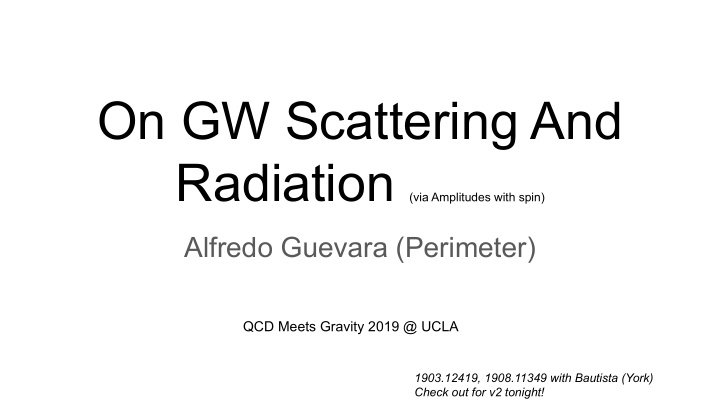



On GW Scattering And Radiation (via Amplitudes with spin) Alfredo Guevara (Perimeter) QCD Meets Gravity 2019 @ UCLA 1903.12419, 1908.11349 with Bautista (York) Check out for v2 tonight!
The Compton amplitude (and its higher multiplicity extensions) encodes information of the conservative dynamics in the Post-Newtonian and Post-Minkowskian frameworks (Rothstein & Neil, Holstein, Bjerrum-Bohr et al, Guevara & Cachazo, …,Bern et al '19,....) It is a current important problem to bootstrap the gravitational Compton to spins s>2 (see Ochirov's and Vines talk)
Part 1: - Construction up to s=2 (revisited) - Multipole Expansion Part 2: - Radiation - GW Scattering
Part I: Construction
QCD at Spin-1
QCD at Spin-1 - Ferrara, Porrati, Telegdi '92: High-energy behaviour can be attained by g=2. This is the natural value of g. - In suitable variables, g=2 eliminates the dependence on m!
QCD at Spin-1 The YM tree-level 4-pt has essentially the same information as the s=1 Compton amplitude. Compactification is more subtle for gravity because of dilaton pieces. Nevertheless, for k3,k4 graviton states it leads to In D=4 the amplitudes reduce to those derived by Arkani-Hamed, Huang and Huang via massive spinor-helicity up to s=2 See also Johanson, Ochirov '19
Double Copy Disgression...
Double Copy Disgression... (Holstein '06)
Double Copy Disgression... (Holstein '06)
Double Copy Disgression... (Holstein '06) This extends to amplitudes with n-2 external gravitons and a single matter line of spin s<2 (and with two matter lines in the classical limit)
Why Double Copy? In order to extract the classical information for spinning particles we need to perform the spin-multipole decomposition. This is easily achieved on the QCD (QED) side. For instance, the soft theorem readily gives [1903.12419] ( , etc…) Note: the classical combination See also Vines, O'Connell, Maybee '19
Why Double Copy? In order to extract the classical information for spinning particles we need to perform the spin-multipole decomposition. This is easily achieved on the QCD (QED) side. For instance, the soft theorem readily gives [1903.12419] ( , etc…) ( )
Why Double Copy? In order to extract the classical information for spinning particles we need to perform the spin-multipole decomposition. This is easily achieved on the QCD (QED) side. For instance, the soft theorem readily gives [1903.12419] ( , etc…) ( )
Part I: Outlook - The Compton amplitudes for minimal coupling can be easily constructed from dimensional reduction. - A double copy structure appears naturally in the multipole expansion.
Part II: Applications
Radiation : The radiation kernel can be computed at leading order from a tree-level 5-point matter amplitude [Luna et al '17; Kosower, Maybee, O'Connell '18] To extract the classical limit, we introduce a complex deformation in the massive legs [Cachazo & Guevara '17] In D>4 we can impose which means that and hence the deformation only explores graviton-exchange poles. These can be parametrized by which corresponds to the average momentum transfer.
The deformation of becomes hence Key point: The multipole expansion is built-in as it comes from the Compton amplitude.
Key point: The multipole expansion is built-in as it comes from the Compton amplitude. with
Key point: The multipole expansion is built-in as it comes from the Compton amplitude. with
Key point: The multipole expansion is built-in as it comes from the Compton amplitude. with
Key point: The multipole expansion is built-in as it comes from the Compton amplitude. with
Key point: The multipole expansion is built-in as it comes from the Compton amplitude. with For 'Fat Gravity' (including dilaton and axion states) the double copy form of the Compton amplitude is inherited: (spurious pole from Compton t-channel)
from Li & Prabhu '18
Scattering of Plane Waves (in progress) Consider a monocromatic wave scattering from a static BH. In the long wavelength regime , the scattering cross section has been computed via BH perturbation methods as a function of the scattereing angle [Peters ‘79, Doran & Lasenby ‘01 ,Dolan ‘07].
Scattering of Plane Waves Scattering of Plane Waves (in progress) Consider a monocromatic wave scattering from a static BH. In the long wavelength regime , the scattering cross section has been computed via BH perturbation methods as a function of the scattereing angle [Peters ‘79, Doran & Lasenby ‘01 ,Dolan ‘07].
Scattering of Plane Waves Scattering of Plane Waves (in progress) Hope : To carry out the scattering computation for Kerr BH, compare with GR literature, and obtain new information about the Compton amplitudes at higher spin. Assume the wave hits the BH along the rotation axis a^mu (analogous to aligned-spin BH scattering) “Double soft limit”
Scattering of Plane Waves Scattering of Plane Waves (in progress) Hope : To carry out the scattering computation for Kerr BH, compare with GR literature, and obtain new information about the Compton amplitudes at higher spin. Assume the wave hits the BH along the rotation axis a^mu (analogous to aligned-spin BH scattering) “Double soft limit” (in D=4)
Now compare to GR literature….
Now compare to GR literature…. (Dolan ‘08) Eventhough the result is linear in spin, the factor of 4 is consistent with a limitation at s=2
Part II: Outlook - We have examined two different classical applications of the Compton amplitude in order to contrast it with the GR literature. - In both cases the results show perfect agreement up to linear order in spin! The gravitational Compton still provides new results at higher orders :( / :)
Recommend
More recommend